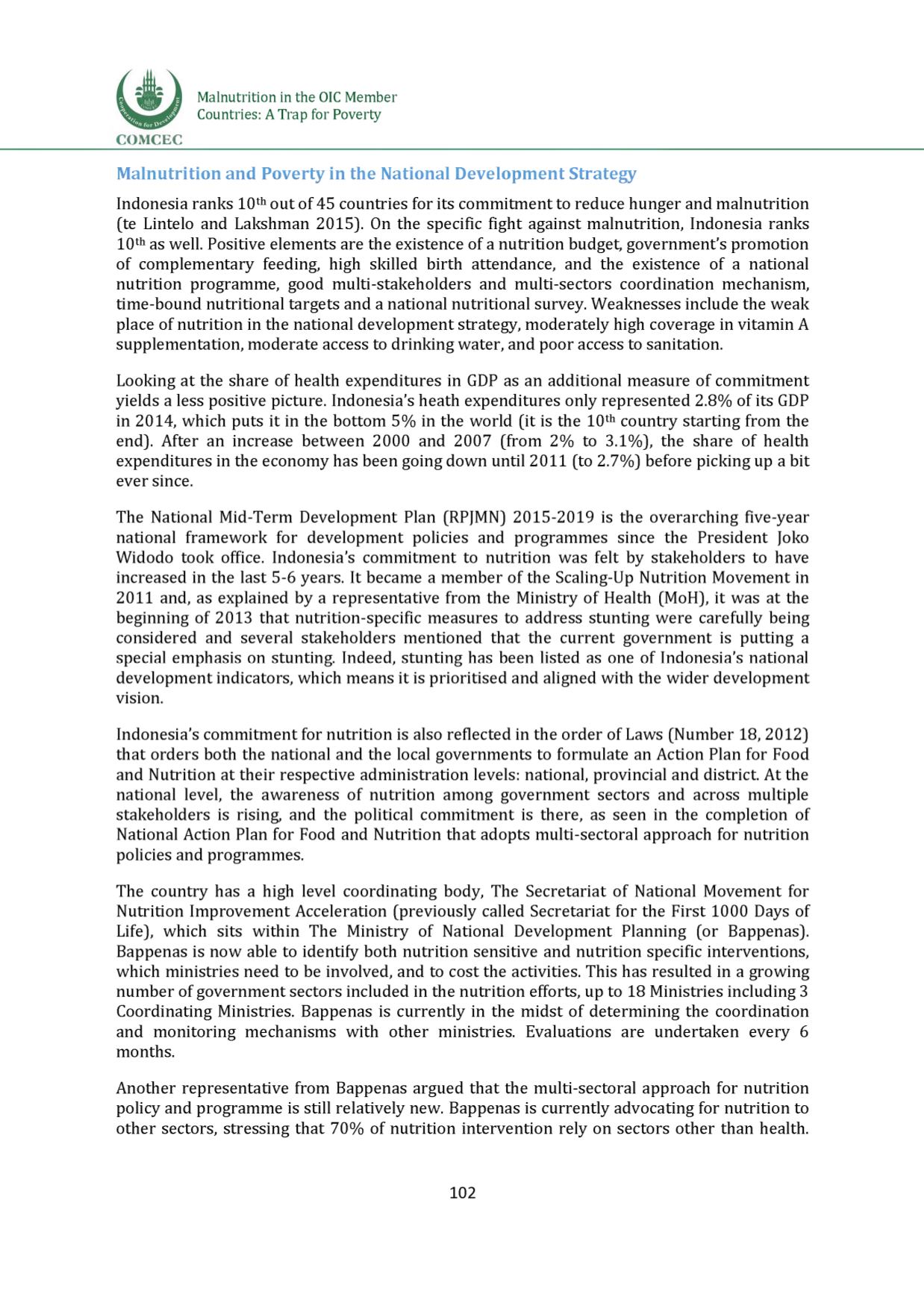

COMCEC
Malnutrition in the OIC Member
Countries: A Trap for Poverty
Malnutrition and Poverty in the National Development Strategy
Indonesia ranks 10thout of 45 countries for its commitment to reduce hunger and malnutrition
(te Lintelo and Lakshman 2015], On the specific fight against malnutrition, Indonesia ranks
10thas well, Positive elements are the existence of a nutrition budget, government's promotion
of complementary feeding, high skilled birth attendance, and the existence of a national
nutrition programme, good multi-stakeholders and multi-sectors coordination mechanism,
time-bound nutritional targets and a national nutritional survey, Weaknesses include the weak
place of nutrition in the national development strategy, moderately high coverage in vitamin A
supplementation, moderate access to drinking water, and poor access to sanitation,
Looking at the share of health expenditures in GDP as an additional measure of commitment
yields a less positive picture, Indonesia's heath expenditures only represented 2.8% of its GDP
in 2014, which puts it in the bottom 5% in the world (it is the 10th country starting from the
end], After an increase between 2000 and 2007 (from 2% to 3.1%), the share of health
expenditures in the economy has been going down until 2011 (to 2,7%) before picking up a bit
ever since,
The National Mid-Term Development Plan (RPJMN) 2015-2019 is the overarching five-year
national framework for development policies and programmes since the President Joko
Widodo took office, Indonesia's commitment to nutrition was felt by stakeholders to have
increased in the last 5-6 years, It became a member of the Scaling-Up Nutrition Movement in
2011 and, as explained by a representative from the Ministry of Health (MoH), it was at the
beginning of 2013 that nutrition-specific measures to address stunting were carefully being
considered and several stakeholders mentioned that the current government is putting a
special emphasis on stunting. Indeed, stunting has been listed as one of Indonesia's national
development indicators, which means it is prioritised and aligned with the wider development
vision,
Indonesia's commitment for nutrition is also reflected in the order of Laws (Number 18, 2012]
that orders both the national and the local governments to formulate an Action Plan for Food
and Nutrition at their respective administration levels: national, provincial and district, At the
national level, the awareness of nutrition among government sectors and across multiple
stakeholders is rising, and the political commitment is there, as seen in the completion of
National Action Plan for Food and Nutrition that adopts multi-sectoral approach for nutrition
policies and programmes,
The country has a high level coordinating body, The Secretariat of National Movement for
Nutrition Improvement Acceleration (previously called Secretariat for the First 1000 Days of
Life], which sits within The Ministry of National Development Planning (or Bappenas],
Bappenas is now able to identify both nutrition sensitive and nutrition specific interventions,
which ministries need to be involved, and to cost the activities, This has resulted in a growing
number of government sectors included in the nutrition efforts, up to 18 Ministries including 3
Coordinating Ministries, Bappenas is currently in the midst of determining the coordination
and monitoring mechanisms with other ministries, Evaluations are undertaken every
6
months,
Another representative from Bappenas argued that the multi-sectoral approach for nutrition
policy and programme is still relatively new, Bappenas is currently advocating for nutrition to
other sectors, stressing that 70% of nutrition intervention rely on sectors other than health,
102
















